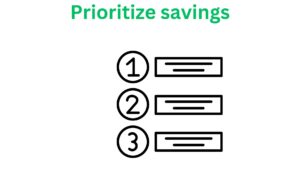Prioritizing savings
Many people may need help prioritizing saving money.
However, prioritizing your savings isn’t as complex as you may think. Here’s a step-by-step guide to help you:
1. Think of yourself and your aspirations: Consider your personal goals and aspirations. What do you want to achieve in the short and long run? This could include buying a house, starting a business, or saving for retirement.
2. Determine your needs: Identify your essential needs, such as housing, food, transportation, and healthcare. It would help if you covered these expenses to maintain a comfortable and secure lifestyle.
3. Identify your wants: Next, consider your wants or desires. These things may bring you enjoyment or enhance your quality of life, but they are not essential. It could be vacations, dining out, or purchasing the latest gadgets.
4. Assess your financial situation: Take a close look at your income and expenses. Calculate how much money you have coming in each month and how much is going out. This will give you a clear understanding of your current financial situation and help you make informed decisions about your savings.
5. Set savings goals: Based on your needs and wants, determine the priority of your savings. If you have immediate needs that require saving, such as an emergency fund or debt repayment, allocate a portion of your savings towards those goals. Then, give another portion towards your long-term goals, such as retirement or education.
= Create a realistic budget =Creating a realistic budget is essential for managing your finances effectively. Here’s how you can do it:
= Reduce unnecessary expenses =Reducing unnecessary expenses is an effective way to free up more money in your budget. Here are some strategies:
Prioritize savings
Prioritizing your savings isn’t a one-size-fits-all approach. It depends on your circumstances and financial goals. Here are a few scenarios to consider:
You may already have savings in a retirement plan that you want to avoid cashing out. In this case, your priority might be to continue contributing to your retirement fund and ensuring its growth over time.
Conversely, you might be looking forward to a once-in-a-lifetime vacation. It’s important to prioritize saving for this specific goal, so you don’t dip into your savings and compromise your plans.
The list of potential financial objectives is endless. It could include saving for a down payment on a house, starting a business, paying off debt, or funding your children’s education. Each of these goals requires careful consideration and planning.
Let’s start prioritizing your savings by following the steps below.
Identify Your Financial Objectives
A. Start by clearly defining what you want to achieve with your finances. Your goals will set the stage for all future planning. Consider the following factors:
Your goals should reflect your unique dreams and aspirations. We all have different priorities and desires. Consider your age, preferences, and personal circumstances when setting your financial objectives.
For example, if climbing Mount Everest at 90 is not on your bucket list, it wouldn’t be a financial goal you need to prioritize. Focus on goals that align with your interests and values.
Consider your lifestyle preferences as well. If you love tropical weather, you’ll unlikely want to live in Alaska. Your financial goals should support the lifestyle you desire.
It’s important to ensure your goals are yours and not influenced by external factors or societal expectations. Take the time to evaluate your aspirations and ensure they align with your values and desires.
By clearly understanding your financial objectives, you can tailor your savings strategies to meet your needs and priorities. This will ultimately lead to a more effective and personalized approach to managing your finances.
Devise a Strategy and Automate Your Savings
With your goals in mind, create a financial plan that will allow you to save money to meet your goals. Consider the following steps:
Example: You could pledge 5% of your after-tax income to build an emergency fund. This percentage can be adjusted based on your income and expenses.
Consider automating your savings. Automating your savings can provide consistency and remove the temptation to spend the money you should be saving.
Automating your savings involves setting up automatic transfers from your checking account to your savings account or setting up direct deposits to allocate a portion of your paycheck directly into your savings.
By automating your savings, you ensure the money is consistently set aside for your goals without relying on willpower or remembering to make manual transfers.
Organize Your Savings Priorities
Arrange your financial goals in order of importance. Here’s why prioritizing your savings is crucial:
Building your emergency fund is important. Cash on hand in case something goes wrong provides financial security and peace of mind.
If you are saving money for a specific goal, such as getting married, and an unexpected expense arises, such as a car accident, there may be better plans than relying on the wedding savings to cover the cost. A separate emergency fund can help you handle unexpected expenses without derailing your other savings goals.
Establishing a fund for a bonafide emergency is crucial. It serves as your safety net, ensuring financial security in case of unexpected events.
Prioritize Retirement Savings
Given the long-term nature and importance of retirement savings, it’s important to start contributing early to benefit from compound interest and secure a comfortable retirement.
Let’s face it: we will probably want to retire someday, and relying solely on Social Security will not provide a pleasant retirement. By prioritizing retirement savings, you can build a nest egg supporting you in your retirement years.
The sooner you start saving for retirement, the better. Thanks to the power of compounding, even small contributions made early on can grow significantly over time.
Begin Investing to Accumulate Wealth
Focusing on growing your wealth through investments is essential once your emergency fund is in place and your debt is under control. Consider the following:
Having a solid emergency fund in place is essential. It provides a financial cushion and ensures funds are available for unexpected expenses.
Being debt-free or managing your debt effectively will free up more money to invest. Paying off high-interest debt and avoiding unnecessary debt will put you in a better position to accumulate wealth.
Focus on growing wealth through investments that align with your risk tolerance and financial goals. This may involve taking calculated risks to achieve higher returns over time.
Save for Everything
Over time, everything we own will need to be repaired or replaced. By saving for these expenses, you can be prepared and avoid unexpected financial burdens and debt.
Yes, saving for everything is an essential aspect of financial planning. Here’s why:
If you need to purchase a blender (not an emergency), tires for the car (maybe not an emergency), or many other things that are not emergencies but don’t have the funds, you may need to rely on credit cards and accumulate debt. By saving money in advance, you can avoid using your emergency funds and unnecessary debt and have the funds readily available when needed.
You don’t need to save it all today; you don’t need a separate account for everything (just one savings account for everything). If you save $100, you can buy a blender; if you save $1,000, you can buy a blender, tires, or both.
If you save $2,000, you can buy tires for the car and a computer and pay the deductible on your home or car insurance.
The point is you will have money on hand when you need it.
Saving money this way will help alleviate the use of your emergency funds and give you more financial stability.
You may be thinking you can’t afford to save for every possible expense, but consider this perspective:
You don’t need to save for everything. If you save $5,000, you can repair or replace anything that costs $5,000 or less. And not use your emergency funds.
Open a separate savings account and label it miscellaneous. Then, make regular contributions to it.
You can automate your savings easily.
Consider this savings account another financial obligation, like paying bills or saving for retirement. Make regular contributions to ensure you always have money for these expenses.
It’s nice when you reach a point where you have enough saved to cover deductibles and the most expensive items you own that are not covered by insurance.
Achieve Additional Financial Objectives
With a solid foundation and strategy, you can diligently work towards accomplishing your other financial goals.
These goals can vary depending on your circumstances and aspirations. They can include continuing education, buying a new home or car, starting a business, or saving for a dream vacation.
By consistently having a clear plan and saving, you can progress towards these objectives and achieve financial success.
Remember, financial planning is a continuous process; reviewing and adjusting your strategies as your circumstances change is essential. You can achieve your financial goals and secure a brighter future with careful planning and disciplined saving habits.
Conclusion
Mastering your savings is key to financial stability and achieving your dreams. Crafting a realistic budget and minimizing unnecessary expenses are essential steps towards allocating more towards your savings. Tailoring your savings strategy to your unique financial situation and goals, such as establishing an emergency fund or planning for retirement, is crucial. Automating savings simplifies meeting these objectives while prioritizing them to ensure essential goals are met first.
Investing in your future and saving for planned and unplanned expenses prepares you for a secure life. Embrace saving for everything to avoid debt, ensuring funds are set aside for emergencies and life’s necessities. You can build a prosperous future by prioritizing savings, creating a solid plan, and staying committed. Start with clear priorities and take decisive steps towards your financial well-being.







